
Throughout the Spring and Summer of , I collaborated with Royal H. Cycles to create a classic low-trail 650B
randonneuring bicycle, then test rode it for 220 miles before it was delivered to the new owner. The project was inspired by Jan Heine, whose championing of this type of bicycle made some of us rabid with curiosity. This review has been long in the works. In parallel I've been preparing an article about the same bike for the
Bicycle Quarterly, and needed to make sure that its content did not overlap too much with this write-up. Now that the
BQ article is finally finished, I feel that the project is complete and would like to reflect upon it here.
If this is the first you are reading about this bike, then you may want to start here before proceeding:
.Making Sense of Rivendell's vs Bicycle Quarterly's Philosophies
.A Beautiful Experiment
.Lovely Bicycle x Royal H Randonneur
.650B Rivendell Sam Hillborne and Randonneur Compared
The posts above describe how the idea for the bike came about, as well as its construction and features, so I will not cover the same ground again here. At some point in the near future I will also write more aboutthe project itself - what it was like to work together with a framebuilder and what I learned in the process. But here I will describe my impressions of the bicycle itself - particularly the aspects that were novel to me. Of course being involved in the bicycle's design, it would be somewhat absurd to either praise or critique its aesthetics and such. The point of this experiment was to form an impression of how this type of bicycle handles, and that is what I will focus on here.
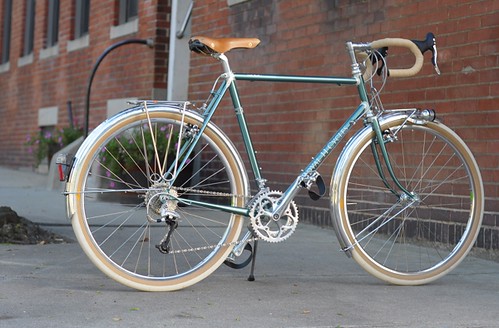 The Low Trail Mystique
The Low Trail MystiqueTo briefly summarise, the Randonneur is a lugged steel low-trail bicycle with 650Bx42mm tires, fenders, dynamo lighting, front and rear racks, and a handlebar bag - made in the style of the 20th century French
constructeurs. "Low-trail" refers to the front-end geometry of a bicycle and it differs from the typical mid/high trail geometry of most roadbikes today. Among classic and vintage bicycle enthusiasts, there is definitely a mystique surrounding the low trail
randonneur, and dramatic descriptions of its handling abound - made all the more dramatic, I suspect, by the fact that this type of bicycle is fairly rare and few have actually ridden it. Certainly that was one of the factors that made me want to try it. The other factor was that Jan Heine's description of the bicycle suggested a combination of speed, responsiveness, comfort, and all-terrain capability that I found attractive.
The biggest surprise about the Randonneur once I began to ride it, was how "normal" it felt. Based on all of the things I had heard and read about low-trail handling by the time the bike was ready, I expected to be blown away by a radically different handling, which I would either love or hate. Instead, the bike felt... like a bike! When I mentioned this earlier, some interpreted it as my implying that I was disappointed with the Randonneur. However that is not what I meant to express at all. I simply meant that I did not find low trail handling to be "difficult" or unusual. While the Randonneur did have some interesting handling characteristics, it felt intuitive to ride and I think that my experience of this is important to communicate. It seems to me that the mystique surrounding low-trail geometry needlessly intimidates people.
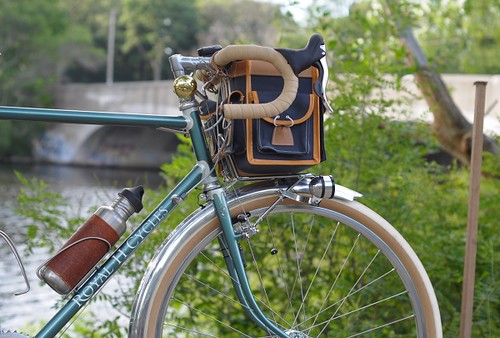
So what did feel different about the low trail handling, even if I found it within the range of normal? Mainly, it was the way the bicycle behaved on turns. At slow speeds I found that I had to be slightly more active when turning than on other road bikes I'd ridden, to pay more attention to the act of turning if that makes sense. Interestingly, this made tight turns easier as opposed to more difficult: I felt as if I were more in control of the turn. I also noticed that on high speed descents along winding roads it was easier to keep my line of travel along the road's curvature; the Randonneur did not "resist" turning at high speeds as I sometimes feel typical roadbikes do. That said, all of this was rather subtle - at no point did this difference alarm or shock me. I would notice the unique behavior on turns and think "Oh neat, so it wants to do
this and not
that" - as opposed to feeling as if there was anything wrong. It's a different feeling is all, and I rather liked it.
Another outcome of low trail (though this is not about handling
per se) is that it allows even small bicycles with fat tires and fenders to avoid toe overlap without the need for an overly long top tube. For me this is a huge deal, because I strongly dislike toe overlap and I ride small bikes. The fact that low-trail geometry automatically eliminates it as a concern is very appealing.
While yet another aspect of the low trail design is said to be its superior ability to handle a front load, in this respect my experience is unhelpful. I rode the bicycle with and without the medium
Berthoud handlebar bag pictured here, and did not notice a significant difference. It felt fine with the bag. It felt fine without. Perhaps this lack of a difference is the point - meaning, you can add a full handlebar bag and the handling remains the same. However, some believe that a low-trail bike is meant to be ridden with a loaded bag at all times and will feel unstable without it. This I did not experience.
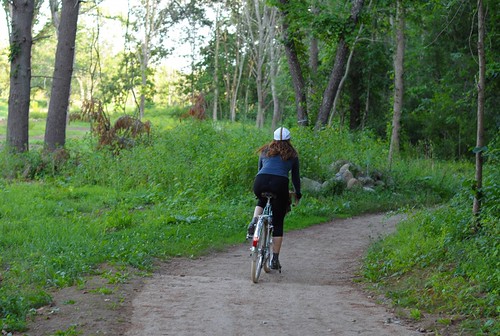 Best of Both Worlds?
Best of Both Worlds?The
Bicycle Quarterly's descriptions of
randonneuring bicycles suggest that they are essentially fully equipped, comfortable racers - thus offering the best aspects of touring bikes and racing bikes combined.
For me, the speed of the Randonneur was not quite on par with that of a racing bike (namely, the
Seven Axiom I'd tried over the summer). However, the Randonneur was faster than my Sam Hillborne.
It was also faster than various vintage roadbikes I've tried.

The weight of the complete bicycle (including bottle cages,
MKS Touring pedals and handlebar bag) was around 26lb (for comparison, my Sam Hillborneis 31lb with a similar setup), which is fairly light given all the stuff it is outfitted with, but not racing bike territory. The standard diameter tubing made it easier for me to carry the bike (my hand could close around the top tube, whereas with oversized tubing it cannot), which was much appreciated.
As far as comfort, the Randonneur was the feather bed of bicycles. While I have no complaints at all about the comfort of my
Rivendell, the Randonneur felt even better, as well as less fatiguing at the end of a ride. In part this may be due to the flexible, standard diameter tubing. Of course given this lightweight and flexible tubing, bicycles like the Randonneur are not suitable for carrying as much weight as touring bikes.
 Notes on Components
Notes on ComponentsI won't go over all of the components this bicycle is fitted with, but would like to highlight the ones that were new to me or made an impression.
As mentioned earlier, I loved the
Grand BoisMaes handlebars with their flat ramps and parallel drops. I am addicted to
Campagnolo ergo levers at this point, and the Veloce model here (also on my
Rivendell) is an economical option that works perfectly well for me. I prefer the
Schmidt SON dynamo hub on this bicycle to the
Shimano hub on my own bike, and the Edelux headlight is the nicest dynamo light I have tried thus far. The
Grand Bois Hetre tires I love so much - both on the Randonneur and on my
Rivendell - that I cannot imagine not owning a bike fitted with them. I was impressed with the
Nitto lugged stem, truly a work of art. The
Berthoud handlebar bag intimidated me somewhat with its beautiful styling, but the multiple sizes it comes in might make it a more convenient alternative to the enormous
Ostrich handlebar bag I have on my own bike.

In the process of riding this bike I also discovered that I prefer the men's
Berthoud touring saddle to the women's. I never wear skirts on roadbikes anyhow, and the longer nose and slightly narrower saddle feels even better here than the shorter, wider version on my own bike.
I am not certain what I think of cantilever brakes - not just on this bicycle, but in general. On fast descents, both the Randonneur and my own canti
Rivendell are rather effortful for me to stop. These brakes are supposed to be very powerful and are the classic brakes to use with this style of bicycle, so I am not sure what the alternatives are. That said, almost everyone I know loves cantis, so I might just be an anomaly (I do have very weak hands).
If I were speccing out this bicycle from scratch today, the one change I would make would be to go with the new
Rene Herse crankset (which was not yet available last summer). This would be a more aesthetically appropriate (albeit much pricier) option than the
Sugino Alpina crankset we used, and its gearing versatility would have allowed us to use a short-cage rear derailleur for an overall more classic look to the drivetrain. None of this however would change the bike's functionality.
I was quite happy with how the Randonneur worked as a whole, including components and accessories. Nothing rattled loose or malfunctioned in the course of my test rides, which included road and gravel.
 Verdict
VerdictBased on my experience with the Randonneur, my impression is that this type of bicycle combines some of the best features of road-racing bikes and all-terrain touring bikes, but does not replace either. If I owned this bicycle, I would still want a pure road-racing bike in addition. And for those interested in fully loaded touring, the Randonneur would not be the right choice for carrying that much weight. But for self-supported long distance events, endurance events, recreational and nature rides, and anything involving off-road trails and mixed terrain I believe this would be just the ticket - both for competitive cycling and for pleasure. The standard diameter tubing, wide 650B tires, fast and responsive handling, fenders, lights and moderate luggage make it an option worth considering for those who feel that touring bikes are overbuilt for them, while road/racing bikes are unsuitable for real-world conditions. In my view, the low trail geometry is not nearly as quirky as some suggest, and has the additional benefit of avoiding the dreaded toe overlap.
A question I've been asked a number of times now over email, is whether I plan to get a bicycle like this made for myself and whether I would recommend it to others. The first part of this question is tough to answer, because if I did get a bicycle like this then it would replace my
Rivendell - I neither need nor can afford to own two 650B road-to-trail bikes! So I just don't know yet whether I want to go through that upheaval. That said, I do think that a bicycle like the Randonneur is extremely appropriate for my style of riding, for all the reasons described in this review. If I did decide to replace my
Rivendell with a lighter and faster bike with the same wide tires and handlebar bag, something like this would be it. As for recommending it to others, I don't even dare go there. We are all so different, and only you can decide whether a bicycle like this is suitable for your needs.
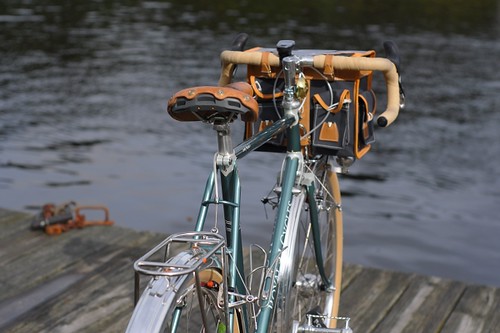 Afterthoughts...
Afterthoughts...An important aside here, is that when designing a bicycle like this, geometry and tubing choice are crucial. If you decide to have a classic low-trail
randonneuringframe built, be sure the builder fully understands your request. It is popular now to refer to all bicycles fitted with fenders, racks, and tires wider than 23mm as "rando bikes," but the bicycle I describe here is a very particular animal and the builder needs to understand that - unless of course you can supply them with the full geometry and specifications. There is now also a number of ready-made
randonneuringframes (though none of them fully lugged, as far as I understand) that may be suitable for those reluctant to go custom, including the Box Dog Pelican and the Rawland RSogn.
The length of this review makes me realise just how much information I have stored up about this bicycle. Stay tuned for the write-up about the project itself - including commentary on the framebuilder's work, detailed descriptions of the geometry and all that. And for those interested in the
Bicycle Quarterly article (which will contain different content still), look for the Spring issue.
My sincere thanks to everyone involved in this project: Bryan of
Royal H. Cycles, Jim A. of
Harris Cyclery, and Jim P. the bicycle's owner - as well as to Jan of the
Bicycle Quarterly for the inspiration and advice. More pictures here and here!
 Every time we travel up and down the east coast we crack up at the 999 billboards advertising South of the Border. For the longest time we only knew of this place from driving by it. At some point we actually stopped and stayed at the campground. To say this place is bizarre is truly understatement.
Every time we travel up and down the east coast we crack up at the 999 billboards advertising South of the Border. For the longest time we only knew of this place from driving by it. At some point we actually stopped and stayed at the campground. To say this place is bizarre is truly understatement. Then as you look around, it seems dated and a bit strange.
Then as you look around, it seems dated and a bit strange. If you look closer, you can see what begins to be really strange.
If you look closer, you can see what begins to be really strange. When we stayed here, Auburn joked that it looked like the set to a really cheesy horror flick. The fact we were the only people we saw, beyond the workers, made it seem even more that way. There is just no other place like this unique little complex.
When we stayed here, Auburn joked that it looked like the set to a really cheesy horror flick. The fact we were the only people we saw, beyond the workers, made it seem even more that way. There is just no other place like this unique little complex. The last time when we visited, I forgot to snap any pictures. I'm glad I remembered this time.
The last time when we visited, I forgot to snap any pictures. I'm glad I remembered this time. I don't know, Ava. I just don't know!
I don't know, Ava. I just don't know! Living the life in SC!
Living the life in SC!




 Well, my first encounter with clipless pedals occurred sooner than I anticipated. Last week the Co-Habitant decided to update his pedals, and the new set arrived in the mail today... which meant that he could gift me his old ones. I thought that surely this gifting would take place some time in the future - a distant, abstract future. But no. Cheerfully he attached them to one of our vintage roadbikes right then and there, so that I could give them a try. Don't get me wrong, I myself had expressed interest in this. But... I don't know, I just didn't expect it to happen immediately!
Well, my first encounter with clipless pedals occurred sooner than I anticipated. Last week the Co-Habitant decided to update his pedals, and the new set arrived in the mail today... which meant that he could gift me his old ones. I thought that surely this gifting would take place some time in the future - a distant, abstract future. But no. Cheerfully he attached them to one of our vintage roadbikes right then and there, so that I could give them a try. Don't get me wrong, I myself had expressed interest in this. But... I don't know, I just didn't expect it to happen immediately!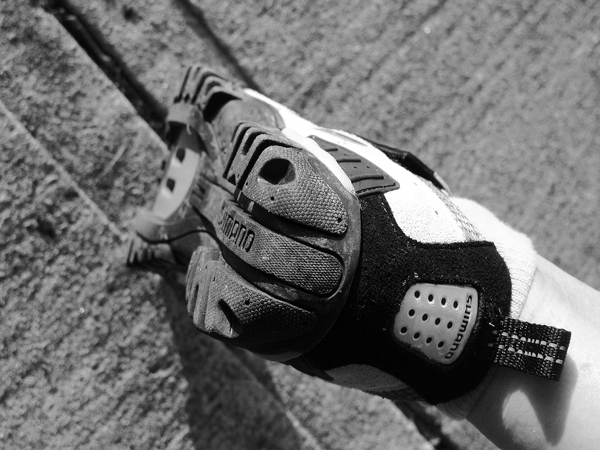 I expected that clipping in would be relatively easy, but clipping out difficult. It was the opposite. At first I could not to clip in. I tried and tried, but my foot stayed on top of the pedal and the mechanism would not engage no matter how hard I pressed. I struggled to figure out what I was doing wrong, but the explanation turned out to be simple: I am a weakling. We had to loosen the tension almost to the max for my foot to engage the mechanism. Even after that, I still had trouble pressing down with enough force and in the exact position necessary for the cleat to catch. Clipping out, on the other hand, was intuitive: the sideways twist of the foot is exactly the same motion required to get out of Power Grips, so I found it natural.Transitioning from the kitchen sink to the trainer, I practiced for some time, clipping in and out successfully. I then decided it was time to go outside. I felt pretty confident at this point. Nothing to this.
I expected that clipping in would be relatively easy, but clipping out difficult. It was the opposite. At first I could not to clip in. I tried and tried, but my foot stayed on top of the pedal and the mechanism would not engage no matter how hard I pressed. I struggled to figure out what I was doing wrong, but the explanation turned out to be simple: I am a weakling. We had to loosen the tension almost to the max for my foot to engage the mechanism. Even after that, I still had trouble pressing down with enough force and in the exact position necessary for the cleat to catch. Clipping out, on the other hand, was intuitive: the sideways twist of the foot is exactly the same motion required to get out of Power Grips, so I found it natural.Transitioning from the kitchen sink to the trainer, I practiced for some time, clipping in and out successfully. I then decided it was time to go outside. I felt pretty confident at this point. Nothing to this. Aside from the tale of failure, I have some observations about the shoe and pedal set-up. I can't find the model name of the shoes, but in retrospect getting clipless shoes with laces was silly. Being stiff and unyielding, they are difficult to put on and tighten, and it's a pain to tuck the laces under the velcro. I am also not sure these pedals are right for me. They are Shimano SPD 520s: mountain bike style, double sided and with a very small surface area. I know that many love this type of pedal, but to me it felt like not enough of my foot was connected. Pedaling on the trainer, I had the sensation that there was too much pressure on the spot where the cleat meets the pedal and that a larger contact area would have been better. Maybe these particular shoes are not stiff enough, or maybe I would do better with a different style of pedals. There seems to be a consensus that the mountain bike clipless system is easier than the road system, but I wonder whether I might prefer the latter. Unfortunately, there is no way to try these things out.
Aside from the tale of failure, I have some observations about the shoe and pedal set-up. I can't find the model name of the shoes, but in retrospect getting clipless shoes with laces was silly. Being stiff and unyielding, they are difficult to put on and tighten, and it's a pain to tuck the laces under the velcro. I am also not sure these pedals are right for me. They are Shimano SPD 520s: mountain bike style, double sided and with a very small surface area. I know that many love this type of pedal, but to me it felt like not enough of my foot was connected. Pedaling on the trainer, I had the sensation that there was too much pressure on the spot where the cleat meets the pedal and that a larger contact area would have been better. Maybe these particular shoes are not stiff enough, or maybe I would do better with a different style of pedals. There seems to be a consensus that the mountain bike clipless system is easier than the road system, but I wonder whether I might prefer the latter. Unfortunately, there is no way to try these things out.

 When drivers behave rudely towards us, we tend to perceive them as being "hostile to cyclists". But what I wonder sometimes, is whether this is a fair assessment given how drivers behave to one another.
When drivers behave rudely towards us, we tend to perceive them as being "hostile to cyclists". But what I wonder sometimes, is whether this is a fair assessment given how drivers behave to one another. Looking over these photos from the Friday after Thanksgiving, I noticed something interesting: Almost everything pictured here is hand-made.The dress I am wearing was made by my mother. The hat and scarf were made by me. Even the bicycle was hand-made by an Italian frame builder for Bella Ciao. This combination was not intentional, but once I noticed it, I found it striking.
Looking over these photos from the Friday after Thanksgiving, I noticed something interesting: Almost everything pictured here is hand-made.The dress I am wearing was made by my mother. The hat and scarf were made by me. Even the bicycle was hand-made by an Italian frame builder for Bella Ciao. This combination was not intentional, but once I noticed it, I found it striking. My mother knitted this elaborate wool dress for herself in the early 1980s and wore it all through her 20s and 30s, after which point she gave it to me. The dress suited her much better, but that has not stopped me from wearing it since I were a teenager. It only occurred to me recently how remarkable it is for a dress like this to survive being worn for three decades by two different women - neither of whom are at all gentle with their clothing. And yet here it is, still looking fresh and current.The tailoring, the textural variation, and the attention to detail are incredible by today's standards - and my mother made tons of this stuff when I was a child, while being a busy career woman, too. (I remember seeing her knit while speaking on the phone and reading a book about mathematics at the same time... )
My mother knitted this elaborate wool dress for herself in the early 1980s and wore it all through her 20s and 30s, after which point she gave it to me. The dress suited her much better, but that has not stopped me from wearing it since I were a teenager. It only occurred to me recently how remarkable it is for a dress like this to survive being worn for three decades by two different women - neither of whom are at all gentle with their clothing. And yet here it is, still looking fresh and current.The tailoring, the textural variation, and the attention to detail are incredible by today's standards - and my mother made tons of this stuff when I was a child, while being a busy career woman, too. (I remember seeing her knit while speaking on the phone and reading a book about mathematics at the same time... ) While my own attempts at knitting are fairly pedestrian compared to my mother's past projects, they do have one feature in common:longevity. I knitted this scarf back in grad school, and 8 years later it remains alive and well, while countless store-bought ones have since fallen apart. My friends, for whom I've made clothing as far back as high school, give me the same feedback - some of them still wear the things I made in the mid-'90s. Noticing this was a big reason why I started to knit and sew again this year: I am not that great at it, but the stuff I make lasts and fits me better than store-bought.
While my own attempts at knitting are fairly pedestrian compared to my mother's past projects, they do have one feature in common:longevity. I knitted this scarf back in grad school, and 8 years later it remains alive and well, while countless store-bought ones have since fallen apart. My friends, for whom I've made clothing as far back as high school, give me the same feedback - some of them still wear the things I made in the mid-'90s. Noticing this was a big reason why I started to knit and sew again this year: I am not that great at it, but the stuff I make lasts and fits me better than store-bought. Over this past year I have done something a little nuts: I've sold or given away most of my clothing - stuff that I had collected and saved for more than 10 years. When I was younger, I was into edgy fashion and quirky designers, but lately that interest has all but faded - replaced by a curiosity regarding how far I can go making things on my own. Aside from knitting, I have been cutting up some of my remaining old clothing and handsewing "new" clothes out of it. Hopefully I will get a sewing machine for the holidays, which will allow me to take things further. In the past I have dabbled in making my own fountain pens as well. And eventually - maybe, just maybe, I would like to try my hand at building bicycle frames - or at least designing them à laGrant Petersen.
Over this past year I have done something a little nuts: I've sold or given away most of my clothing - stuff that I had collected and saved for more than 10 years. When I was younger, I was into edgy fashion and quirky designers, but lately that interest has all but faded - replaced by a curiosity regarding how far I can go making things on my own. Aside from knitting, I have been cutting up some of my remaining old clothing and handsewing "new" clothes out of it. Hopefully I will get a sewing machine for the holidays, which will allow me to take things further. In the past I have dabbled in making my own fountain pens as well. And eventually - maybe, just maybe, I would like to try my hand at building bicycle frames - or at least designing them à laGrant Petersen.
 I've been helping a Lovely Bicycle reader with the process of ordering a custom bike, and he sent me something rather wonderful as a Thank You gift.
I've been helping a Lovely Bicycle reader with the process of ordering a custom bike, and he sent me something rather wonderful as a Thank You gift. It's a beautiful little antique case, about 4x3", with the tiniest, delicate latch closure. And inside of it, there is this:
It's a beautiful little antique case, about 4x3", with the tiniest, delicate latch closure. And inside of it, there is this: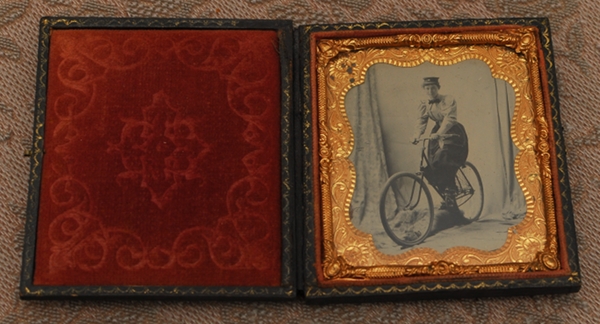 An ambrotype portrait of a young lady on her bicycle, c.1893-94. The ambrotype is one of the oldest methods of photography, where the image is captured as a positive on glass using a wet plate process. Being on glass, ambrotypes are extremely fragile, which is why they were preserved in these enclosed, padded cases. And even with these careful storage methods, not many of them remain. This is a fine gift indeed, to say the least - especially for one obsessed with both bicycles and photographic processes.
An ambrotype portrait of a young lady on her bicycle, c.1893-94. The ambrotype is one of the oldest methods of photography, where the image is captured as a positive on glass using a wet plate process. Being on glass, ambrotypes are extremely fragile, which is why they were preserved in these enclosed, padded cases. And even with these careful storage methods, not many of them remain. This is a fine gift indeed, to say the least - especially for one obsessed with both bicycles and photographic processes.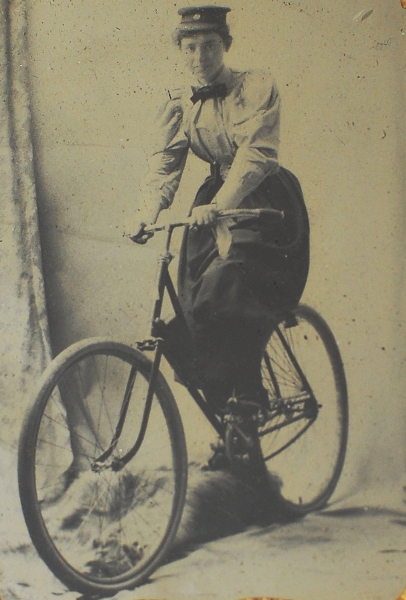 Here is a close-up of the image itself. I cannot remove it from its case, so excuse the murkiness. Notice that it is a mirror image - the drivetrain is on the wrong side. The first commercial freewheel was produced by Sachs in 1898, which means that this lady and others of her era were riding fixed gears. Also, notice the absence of fenders, but the presence of dress guards - at least her muddy skirt would not get stuck in the spokes? Otherwise, the bicycle is a fairly classic lady's Roadster (and apropos the earlier gender discussion - yes, thesewere made specifically for ladies).
Here is a close-up of the image itself. I cannot remove it from its case, so excuse the murkiness. Notice that it is a mirror image - the drivetrain is on the wrong side. The first commercial freewheel was produced by Sachs in 1898, which means that this lady and others of her era were riding fixed gears. Also, notice the absence of fenders, but the presence of dress guards - at least her muddy skirt would not get stuck in the spokes? Otherwise, the bicycle is a fairly classic lady's Roadster (and apropos the earlier gender discussion - yes, thesewere made specifically for ladies).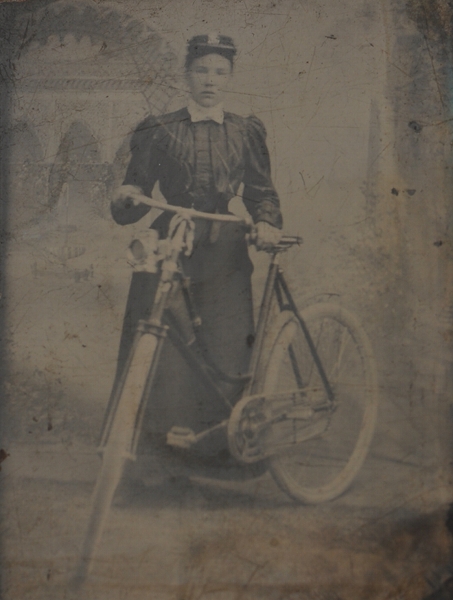 The encasedambrotypecame in a set with a free-standingtintype- another positive photographic process, this one created on a sheet of blackened iron. Just amazing. Again, there is the mirror image effect. The bicycle here is similar, but with a fancier chaincase and with a headlamp. The person who sent me these pictures believes the women might be bicycle messengers, though it is also possible that the caps represent cycling clubs that were popular at the time. I must admit that I liked the image of them cycling on fixed gear loop frames through the city delivering letters.
The encasedambrotypecame in a set with a free-standingtintype- another positive photographic process, this one created on a sheet of blackened iron. Just amazing. Again, there is the mirror image effect. The bicycle here is similar, but with a fancier chaincase and with a headlamp. The person who sent me these pictures believes the women might be bicycle messengers, though it is also possible that the caps represent cycling clubs that were popular at the time. I must admit that I liked the image of them cycling on fixed gear loop frames through the city delivering letters.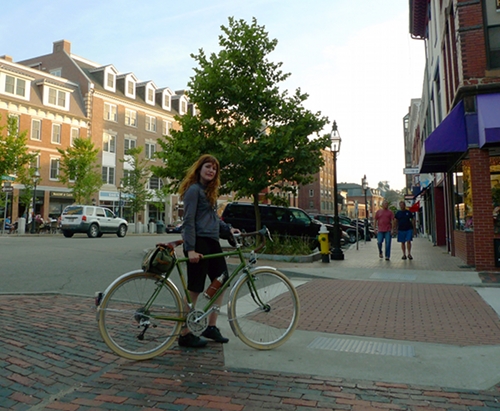 Small confession: For the past couple of days, I have been using my road bike for transportation. Not out of choice, but out of necessity - I can't spend more than 2 minutes on any of my upright or semi-upright bicycles right now without pain.
Small confession: For the past couple of days, I have been using my road bike for transportation. Not out of choice, but out of necessity - I can't spend more than 2 minutes on any of my upright or semi-upright bicycles right now without pain.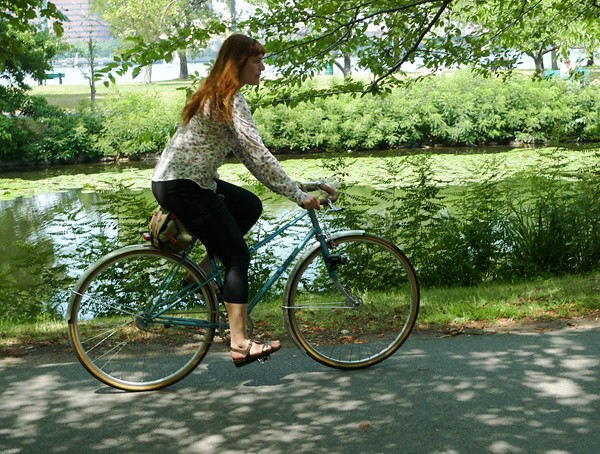 In my excitement about Marianne's conversion, I took her on her longest ride yet as a fixed gear - 28 miles. For the first 20 miles, everything was fine. The bike's geometry has never been the most comfortable, but as a fixed gear it felt better than ever and I was pedaling happily. But then, with just 8 miles to go, I suddenly became aware of a rapidly growing discomfort - not just in one area, but in several: in my shoulders, arms, back, pelvis, joints - pain seemed to be everywhere and it attacked me all at once. By the time I got home, I felt as if I had been run over by a train. I took some Ibuprofen and expected it would go away in the morning. But when I tried to ride my vintage Raleigh the next day, I felt the same pain immediately and barely managed to cycle to my destination a mere mile from home.
In my excitement about Marianne's conversion, I took her on her longest ride yet as a fixed gear - 28 miles. For the first 20 miles, everything was fine. The bike's geometry has never been the most comfortable, but as a fixed gear it felt better than ever and I was pedaling happily. But then, with just 8 miles to go, I suddenly became aware of a rapidly growing discomfort - not just in one area, but in several: in my shoulders, arms, back, pelvis, joints - pain seemed to be everywhere and it attacked me all at once. By the time I got home, I felt as if I had been run over by a train. I took some Ibuprofen and expected it would go away in the morning. But when I tried to ride my vintage Raleigh the next day, I felt the same pain immediately and barely managed to cycle to my destination a mere mile from home.  Mysteriously, I can still ride my roadbike with zero of the pain I experience on the upright bikes. Somehow being in the drop-bar position on the comfortable Rivendell does not activate any of the same discomfort.So, I am now in the ironic situation where I can go for 35 mile rides on a roadbike, but can't cycle for even a couple of miles on any of my city bicycles. Argh!
Mysteriously, I can still ride my roadbike with zero of the pain I experience on the upright bikes. Somehow being in the drop-bar position on the comfortable Rivendell does not activate any of the same discomfort.So, I am now in the ironic situation where I can go for 35 mile rides on a roadbike, but can't cycle for even a couple of miles on any of my city bicycles. Argh! But this particular situation aside, I have been thinking a lot lately about comfort, and, more specifically, about when it is appropriate to declare that a bicycle is "comfortable". Had I limited my rides on Marianne to 20 miles at a time or less, I would have thought she was perfectly comfortable. I could have ridden her this way for years, thinking that I had a comfortable bike - but I would have been wrong. And that is why it is so difficult to determine a bicycle's comfort based on the sort of test rides you take at the bike shop, or even short rides on your own. Bicycle A might feel better than Bicycle B after a short spin, but how will they compare after mile 20? mile 50? mile 100? You just do not know, until you actually ride the bicycle for that distance.
But this particular situation aside, I have been thinking a lot lately about comfort, and, more specifically, about when it is appropriate to declare that a bicycle is "comfortable". Had I limited my rides on Marianne to 20 miles at a time or less, I would have thought she was perfectly comfortable. I could have ridden her this way for years, thinking that I had a comfortable bike - but I would have been wrong. And that is why it is so difficult to determine a bicycle's comfort based on the sort of test rides you take at the bike shop, or even short rides on your own. Bicycle A might feel better than Bicycle B after a short spin, but how will they compare after mile 20? mile 50? mile 100? You just do not know, until you actually ride the bicycle for that distance.





 They are so close, we give each other a Good Morning wave sometimes.
They are so close, we give each other a Good Morning wave sometimes. What a way to start the day! Even better than coffee!
What a way to start the day! Even better than coffee! Beautiful, beautiful, beautiful! So beautiful in fact, I've been known to trip on the speed bumps because I'm watching them instead of the road.
Beautiful, beautiful, beautiful! So beautiful in fact, I've been known to trip on the speed bumps because I'm watching them instead of the road. Living the life in beautiful Florida!
Living the life in beautiful Florida!
 Throughout the Spring and Summer of , I collaborated with Royal H. Cycles to create a classic low-trail 650B randonneuring bicycle, then test rode it for 220 miles before it was delivered to the new owner. The project was inspired by Jan Heine, whose championing of this type of bicycle made some of us rabid with curiosity. This review has been long in the works. In parallel I've been preparing an article about the same bike for the Bicycle Quarterly, and needed to make sure that its content did not overlap too much with this write-up. Now that the BQ article is finally finished, I feel that the project is complete and would like to reflect upon it here.
Throughout the Spring and Summer of , I collaborated with Royal H. Cycles to create a classic low-trail 650B randonneuring bicycle, then test rode it for 220 miles before it was delivered to the new owner. The project was inspired by Jan Heine, whose championing of this type of bicycle made some of us rabid with curiosity. This review has been long in the works. In parallel I've been preparing an article about the same bike for the Bicycle Quarterly, and needed to make sure that its content did not overlap too much with this write-up. Now that the BQ article is finally finished, I feel that the project is complete and would like to reflect upon it here.
 So what did feel different about the low trail handling, even if I found it within the range of normal? Mainly, it was the way the bicycle behaved on turns. At slow speeds I found that I had to be slightly more active when turning than on other road bikes I'd ridden, to pay more attention to the act of turning if that makes sense. Interestingly, this made tight turns easier as opposed to more difficult: I felt as if I were more in control of the turn. I also noticed that on high speed descents along winding roads it was easier to keep my line of travel along the road's curvature; the Randonneur did not "resist" turning at high speeds as I sometimes feel typical roadbikes do. That said, all of this was rather subtle - at no point did this difference alarm or shock me. I would notice the unique behavior on turns and think "Oh neat, so it wants to do this and not that" - as opposed to feeling as if there was anything wrong. It's a different feeling is all, and I rather liked it.
So what did feel different about the low trail handling, even if I found it within the range of normal? Mainly, it was the way the bicycle behaved on turns. At slow speeds I found that I had to be slightly more active when turning than on other road bikes I'd ridden, to pay more attention to the act of turning if that makes sense. Interestingly, this made tight turns easier as opposed to more difficult: I felt as if I were more in control of the turn. I also noticed that on high speed descents along winding roads it was easier to keep my line of travel along the road's curvature; the Randonneur did not "resist" turning at high speeds as I sometimes feel typical roadbikes do. That said, all of this was rather subtle - at no point did this difference alarm or shock me. I would notice the unique behavior on turns and think "Oh neat, so it wants to do this and not that" - as opposed to feeling as if there was anything wrong. It's a different feeling is all, and I rather liked it.
 The weight of the complete bicycle (including bottle cages, MKS Touring pedals and handlebar bag) was around 26lb (for comparison, my Sam Hillborneis 31lb with a similar setup), which is fairly light given all the stuff it is outfitted with, but not racing bike territory. The standard diameter tubing made it easier for me to carry the bike (my hand could close around the top tube, whereas with oversized tubing it cannot), which was much appreciated.
The weight of the complete bicycle (including bottle cages, MKS Touring pedals and handlebar bag) was around 26lb (for comparison, my Sam Hillborneis 31lb with a similar setup), which is fairly light given all the stuff it is outfitted with, but not racing bike territory. The standard diameter tubing made it easier for me to carry the bike (my hand could close around the top tube, whereas with oversized tubing it cannot), which was much appreciated.
 In the process of riding this bike I also discovered that I prefer the men's Berthoud touring saddle to the women's. I never wear skirts on roadbikes anyhow, and the longer nose and slightly narrower saddle feels even better here than the shorter, wider version on my own bike.
In the process of riding this bike I also discovered that I prefer the men's Berthoud touring saddle to the women's. I never wear skirts on roadbikes anyhow, and the longer nose and slightly narrower saddle feels even better here than the shorter, wider version on my own bike.
